The Natural & the Manufactured post-exhibition essay
THE SAME RIVER
by J.P. King
The same river. The glaciers. Water. Waves washing up against the dykes of Dawson City: civilized, but far from civilization. While nearly all of us arrived at this place by road or plane, it was once the Yukon River that would have brought us here. The river was a test. A gateway. Survival. Struggle. A gruelling battle. A way of life. The Tr’ondëk Hwëch’in knew the site where the Klondike and Yukon Rivers merged as a fishing camp. The prospectors knew it for a different wealth.
Water, like humans, settles, adapts, and continues to flow. It is resilient and never ceases its constant cycle. In The Natural & the Manufactured exhibit of 2012, a site-specific sculpture offers a humble warning against the disappearance of water, an exhibition of man-made materials likens humanity to the levelling forces of glacial movement, an audio installation enlivens the airwaves with the stories, gossip, and history of Dawson City, and lastly, a conversational lecture contemplates the role of a creative life.
A Silent Siren: Kuiper & Suter’s Whispers of Thaw & Warmth
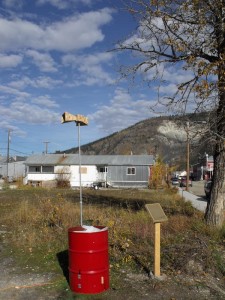
Kuiper & Suter | “Burned” installed on
2nd avenue, Dawson City
In an empty field, on 2nd Avenue, stands an unassuming oil barrel painted fire engine red. A thin pipe attached to its side rises to the height of a tall man’s reach, and atop it, like a bird house, is a miniature wooden warning siren. It’s an object in the shape of catastrophic memory, the kind of alarm that once sent children under desks, and mothers to the bunkers. From the boardwalk, this collaborative effort from New Brunswick-based artists Adriana Kuiper and Ryan Suter is silent, in stasis, and waiting. I move toward it cautiously, out of a fear that it may begin to scream at any moment, and yet as the distance between the barrel and I closes, I am able to see something gem-like suspended at its centre. It takes only a moment to realize that it is nothing geologic, but quite the opposite: the barrel contains a block of ice cast in the shape of a wooden log, now melting in the hot summer sun.
Like a fire, this silent monument’s material existence is rapidly changing before my eyes, and yet it is the opposite of warming. The transformation is live, visible, and without smoke. The logs are dripping down into a catch basin. As I wait for the roar of a truck behind me to pass, I strain to get closer to the apparatus. As silence returns to the field I am able to hear the humble rhythm of an amplified water drop. Drip. Drip. Drop. It isn’t loud. It doesn’t suggest the type of terror this shape of speaker is famous for. Instead, it sounds as though I am in a damp cave, or huddled beneath a white pine after a light rain.
The use of vernacular materials makes Burned an installation that is easily camouflaged in the setting of Dawson City. The acoustics alert only those who care to investigate the barrel. Wood is a substance entirely inseparable from the natural environment, but a log with cleanly cut ends exhibits civilized intervention. The installation questions the projected crisis of fresh water, the current melting of glaciers, the effects of CO2 emissions, and inefficient use of resources. With barely a whisper, the barrel and its electro-acoustic apparatus asks the empty field: How loud must the disappearance of something be before we begin to listen?
As day turns to night and ice has melted away, all that is left is an extinguished barrel and a mute siren. The gallery assistant will recycle the water of the melted log into a hollow mould and place it in the freezer. Tomorrow the ice fire will be built up again, piled high under the sun, and left in futility to sing its own death song.
Wiped Clean and Left Behind: B.J. Vogt’s Glacial Movements of Civilization
Across the street and inside the ODD Gallery is a more formal set of sculptural works, photographs, and a single channel video by St. Louis artist, B.J. Vogt. This exhibit, titled Ebb & Flow, seeks to investigate a metaphor of humanity as a natural process akin to glacial movement and river flows. Along one wall, twelve photographs of gravel mounds, rock piles, sand heaps, and lumps of dirt are set against bright blue Dawson City skies. This series, titled Kames, makes reference to a unique geological formation, in which deposits of earth build-up on top of glaciers and are laid to rest as the ice retreats. One thinks of mountains in miniature, or rock slides, but really the piles are less majestic and will instead find utility as road gravel, or in-fill. These mounds are records of our activity and gestures of progress. Some of the Kames appear freshly dropped, while others facing neglect have weeds growing up through them. In these portraits, characters begin to emerge from these rather lifeless mounds: the lazy, the busy, the strong, and the sloppy.
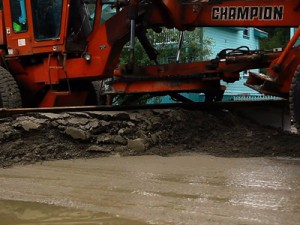
BJ Vogt: “Advancing Face-Champion Glacier”, HD Video, 2012.
At the far end of the gallery a screen holds a seemingly still image of a yellow industrial vehicle: a road-grader turning over dirt and gravel. Looking back at the screen moments later I see that it is not a still, but an almost imperceptibly slow video-sequence. The machine crawls across the screen. What was ten seconds of life becomes a 30 minute memorial. The gravel slowly twists in the air and is forced in a wave-like arc, crashing back into the ground. I watch as a sliver in the history of earth’s transformation bends. Dawson City’s gravel roads are turned, folded, and kneaded like bread, smoothed flat and readied for transport. Like the ice age that retreated over 10,000 years ago, the road grader wipes our marks clean, and prepares a fresh surface.
On plinths scattered throughout the gallery are smooth and weightless river rocks constructed from melted plastic shopping bags. The black and beige stones are covered in yellow and grey striations. They have the uncanny appearance of being born of ancient volcanic activity, and committed to a life of tumbling in a river. Deceptively simple, the repurposed material is almost seamless, and one might sooner pass them by, thinking them to be actual river rocks pulled from the shores of the Klondike, rather than the laboured and meticulous masses of man-made material that they are.
In his objects, images, and installations, Vogt melts away the distinctions between natural and artificial, civilized and natural. From his perspective: Nature is a Machine. It fabricates like we do. Watch the extrusion of a steel pipe with the same eyes as those which see a twig grow from a branch, or listen to a cicada hiss like the static of a mistuned radio. We are reminded that the distance between Industry and Nature is never as far as we think. The use of man-made material mimicking natural form is a constant simple message: the garbage of human progress piles up, unlike nature’s cast-offs and waste, which is always re-used and absorbed back into the cycle. Thus far, our ingenuity arrives as a dead assembly.
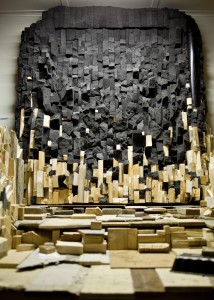
BJ Vogt: “Polypropylene 2”, Mixed-media site-specific installation, 2012
The final and most dynamic piece inhabiting the gallery is a waterfall that spits nurdles (the ubiquitous plastic pellets at the centre of all plastic-based industry) over a wooden cliff-face and down into a black basin. The closed-loop plastic waterfall sounds like a heavy rain. Material made fluid and forgiving. One can’t help but think of the environmental messages at play: pollution of fresh water, poisoning of wetlands, and plastic’s overtaking capacity to invade the highest, deepest, and furthest reaches of the earth. Through simple, materially-comparative strategies Vogt makes the base ingredients of industry point at our shameful feelings towards civilization, and our fantasy of an untouched and perfect model of nature.
Who To Do The Telling: Andrew O’Connor’s Pirate Radio Utopia
As the late summer sun dips behind the hill, shadowing Dawson City, I am walking down 3rd Avenue with an awkwardly large stereo-system on my shoulder and following a small hand-drawn map. Emerging through the static are the voices of local Dawsonites recounting stories of past and present, gossip, myth, and lore. As I cross Queen Street the static evaporates and a clear single voice begins to speak: “We longed for an era where you wanted something and you went out and got it.”
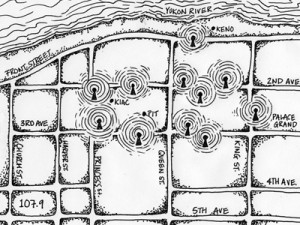
Andrew O’Connor: “Frequencies: Dawson City, Interactive audio installation, 2012. (Installation map by Rian Lougheed-Smith)
Filled with nostalgia and reflection, this narrative is only one of many that constitute Frequencies: Dawson City, an interactive sound installation of Toronto-based Andrew O’Connor. During his summer residency at KIAC, O’Connor collected over 25 hours of storytelling from locals and collaged them into thematic chapters, which amount to an alternative, personalized, and private aural history of Dawson City. This documentary, whose only access point is a personal radio tuned to various low-watt FM transmitters placed in 11 locations across town, will never provide the same narrative sequence twice. For me, the project recalls the words of Heraclitus, who said “It is impossible to step into the same river twice.” Each chapter is a different duration, and there is no firmness to the order of your route. As one passes between transmitters, waves of radio noise wash over the voices, which join together and then separate again. Behind me, the sound of an engine turning over mixes with a laughing baby, boots on the boardwalk, and the clicking of a raven’s feet hopping on gravel. The stories being told are the ones I always wanted hear, but never knew who to ask to do the telling. Loops of memory pass through buildings, bodies, and drift out into space. I allow the voices to wash over me, drown me in history, and I emerge bathed in the narratives that make this place what it is.
The stories address local concerns, like the history of Bombay Peggy’s, the RCMP, looking for love in the North, mining, the Flood of ’79, aboriginal issues, and Dawson as a place of escape and acceptance. Listeners may recognize the voices of some of Dawson’s brightest characters, like Eldo Enns who describes a final frontier and “a place of forgiveness where people can put their pasts behind them.”
Playing on the traditions of pirate and guerrilla radio, and taking inspiration from Tetsuo Kegowa’s vision of a polymorphous radio utopia, O’Connor scrawls an auditory graffiti into airwaves of Dawson. This work is an invitation to a game of hide and seek, and while all eleven chapters play at once, at all times of the day, you’ll only ever be able to step from one to the next, catching brief moments between stations, where old voices come together to tell entirely new stories.
Selecting One Stone: Sheila Heti’s Soul of Time
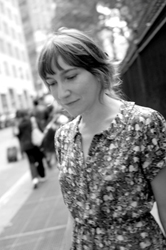
Sheila Heti
Above the ODD Gallery, on a warm evening in late August, a crowd piles into the Odd Fellows Hall to hear Sheila Heti speak about “The Soul of Time”. What proceeds is less of a lecture and far more a conversation and divination session in which Heti, assisted by a handful of pennies and a tome of ancient Chinese philosophy, invites the audience to ruminate upon a series of curious questions exploring the role of the artist within a natural and manufactured world.
Heti begins by describing a dream where she comes to understand a new form of narrative, in which the actors of a drama interact with the audience. “The complete world that is created in the artwork is broken, and the artwork is shown to be a construction. And then this channel is made between the life of the audience and the work itself.” We begin to see that we are the material with which she will work over the next hour. We are introduced to the I Ching (The Book of Changes). We are told that there are 64 States of Being, Phases, or Directions, and that while they are all simultaneously active at once we are only capable of understanding one at a time. We are invited collectively, in our heads, to ask this question: Where am I…What state are we in? Then the coins are thrown. Tails. Heads. Tails. Heads. Heads. Tails. #47 Oppression/Exhaustion. The image of: Lake over water.
Sheila Heti says that she doesn’t really believe in divination, but wonders how it is possible that throwing coins at random might accurately describe a state of being. “It is a way of simplifying the chaos,” she explains. These methods are used as artificial constraints in isolating a single state of understanding. Simply said, “you can’t move in 64 directions. You can only move in one.” These kinds of games bridge the natural and manufactured worlds, isolating something from everything so that we may understand it.
The tables turn. Yes/No answers have been prepared randomly in the form of a slide projection, and the audience is invited to ask the questions. Through this we discover that the soul is dependent on the natural world. It is a manifestation of time. We must have experiences for time to eat. Time won’t grow fat. From the soul we find our nourishment. Time does forget.
Healers, shamans, storytellers and artists have long been the keepers of wisdom. It is in their active distillation of chaos, their fabrication of a singularity within the endless natural world, that we may glimpse the nucleus of our own existence: the soul. Like selecting one shiny stone from the river bottom teaches us what kilometres of water covers over, it is an artist’s goal and duty to re-structure a complex world, which we think we understand, and give it back to us in a single state. It is this gift which becomes the heart of emotion, and the soul of time.
The River Brought Us Here: N&M, Dawson City, 2012
These events, installations, and exhibits tucked up in the top corner of Canada show a multidisciplinary understanding of civilization’s role in an ever-changing natural world. The metaphor of water, rivers, glaciers, and ice all capture the essence of Dawson City’s geography, climate, and peculiar history. In each of their works the artist, or pair of artists has offered the community their own understanding of the world using the materials and mediums that best explain their visions.
Toronto, November 2012
_______________________________
BIOGRAPHY
JP KING is an artist, writer, critic, publisher & printer living in Toronto. He runs Paper Pusher Printworks, a Risograph printing operation with a literary and arts publishing arm. He currently writes for Kolaj, an international collage magazine run out of Montreal, and his book of narrative poems and illustrations, We Will Be Fish, was first published by PistolPress in 2008. As an artist-in-residence at KIAC in the fall of 2011, King took inspiration from the Gold Rush era to work on his anachronistic book project Manhole, which explores a future vision of Canada sustaining itself on an excavated landfill. His personal work explores contemporary mythology, masculinity, garbage, and collective activity. His obsession with paper manifests itself in collage, installation, murals, and multiples,
Back to top






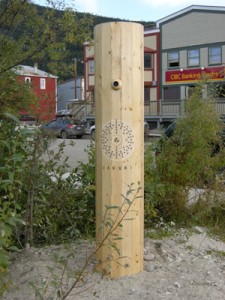 Stratman and Badgett’s public art installation Augural Pair consisted of two six-foot tall pine viewing stations. The first scope was installed on Second Avenue between Queen and Princess Streets. There was no explanatory plaque or sign, and the only decoration on the smooth blond wood was an electron shell diagram for gold, element 79 in the Periodic Table of Elements. The scope looked to a second-level window at the CIBC Bank, where a red digital display listed the current price of gold as provided by a live internet feed. Through the viewfinder, the commodity of gold is reified as we see the arcane value of the precious metal discretely quantified. Though the concept of gold’s value has been made real through its quantification, it becomes clear that we still cannot reach this gold which we desire; the scope emphasizes our distance.
Stratman and Badgett’s public art installation Augural Pair consisted of two six-foot tall pine viewing stations. The first scope was installed on Second Avenue between Queen and Princess Streets. There was no explanatory plaque or sign, and the only decoration on the smooth blond wood was an electron shell diagram for gold, element 79 in the Periodic Table of Elements. The scope looked to a second-level window at the CIBC Bank, where a red digital display listed the current price of gold as provided by a live internet feed. Through the viewfinder, the commodity of gold is reified as we see the arcane value of the precious metal discretely quantified. Though the concept of gold’s value has been made real through its quantification, it becomes clear that we still cannot reach this gold which we desire; the scope emphasizes our distance.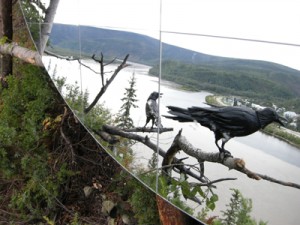 Similarly, the second scope in Augural Pair (also six-foot tall, but lacking any inscription) was placed on the bank of the Yukon River, looking up and across to a mirrored disk installed on land belonging to the Tr’ondëk Hwëch’in First Nation. The reflective disk was surrounded by realistic life-sized sculptures of ravens that responded to the mirror and invited interactions with live ravens. Again, through the use of the viewfinder and the division of the river, the viewer’s distance from the object is emphasized. Likewise, desire was heightened as anything in peripheral vision turned to black through the viewfinder. Depending on the weather, the form of desire changed. On a pleasant day with no clouds, the mirror reflected the blue sky in a bright, obvious way, creating the desire for something to extract. On a gray, overcast day, the disk resembled a hole in the landscape, exposing a desire for something that had already been extracted, or the need to be whole.
Similarly, the second scope in Augural Pair (also six-foot tall, but lacking any inscription) was placed on the bank of the Yukon River, looking up and across to a mirrored disk installed on land belonging to the Tr’ondëk Hwëch’in First Nation. The reflective disk was surrounded by realistic life-sized sculptures of ravens that responded to the mirror and invited interactions with live ravens. Again, through the use of the viewfinder and the division of the river, the viewer’s distance from the object is emphasized. Likewise, desire was heightened as anything in peripheral vision turned to black through the viewfinder. Depending on the weather, the form of desire changed. On a pleasant day with no clouds, the mirror reflected the blue sky in a bright, obvious way, creating the desire for something to extract. On a gray, overcast day, the disk resembled a hole in the landscape, exposing a desire for something that had already been extracted, or the need to be whole.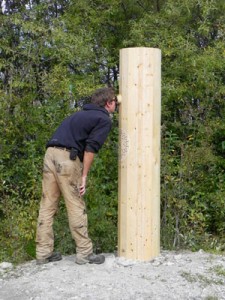 Viewers familiar with Dawson and the Yukon could identify the site-specific elements of Augural Pair. For example, the subject of gold was a timely inclusion in the project. In the summer of 2011, the historic Gold Rush town was buzzing with the idea of a second gold rush. GroundTruth Exploration, a local mineral exploration company, boasted an increased summer staff of over 70 soil samplers or “dirtbaggers,” ostensibly correlating with the appearance of new expediting and helicopter companies.
Viewers familiar with Dawson and the Yukon could identify the site-specific elements of Augural Pair. For example, the subject of gold was a timely inclusion in the project. In the summer of 2011, the historic Gold Rush town was buzzing with the idea of a second gold rush. GroundTruth Exploration, a local mineral exploration company, boasted an increased summer staff of over 70 soil samplers or “dirtbaggers,” ostensibly correlating with the appearance of new expediting and helicopter companies. 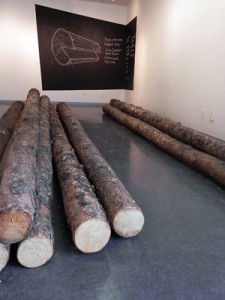 My initial response at the opening of The Veblen Good wasn’t much more nuanced. The chalkboard wall work listing “those who have helped me, those I still hope will help me, and those who wronged me” gave context and imbued humour into the massive logs with the same names inscribed into them. The Photoshopped facelifts to the S.S. Keno (now the H.U. Obrist) and a Holland America tourbus (rebranded as Martin Kippenberger Tours) provided easy laughs, as did the witty autobiographical watercolours of Burns’ outdoor expeditions with curators, collectors, and editors. This was all fine and good, but I couldn’t help feeling cheated by Burns’ show. Did he even consider the place he had been living in for the past month?
My initial response at the opening of The Veblen Good wasn’t much more nuanced. The chalkboard wall work listing “those who have helped me, those I still hope will help me, and those who wronged me” gave context and imbued humour into the massive logs with the same names inscribed into them. The Photoshopped facelifts to the S.S. Keno (now the H.U. Obrist) and a Holland America tourbus (rebranded as Martin Kippenberger Tours) provided easy laughs, as did the witty autobiographical watercolours of Burns’ outdoor expeditions with curators, collectors, and editors. This was all fine and good, but I couldn’t help feeling cheated by Burns’ show. Did he even consider the place he had been living in for the past month?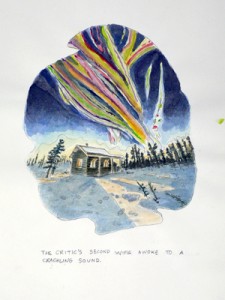 But what really matters to Dawson is how Burns illustrated the social dynamics of a small town in the North in ingenious, subtle simplicity. In a town that so rigidly attempts to exhibit a coherent identity based on a four-year period in history, it becomes necessary to map new stories and heroes and values onto daily life in order to make present-day Dawson a place worth living. It requires carving a place for yourself and injecting your own brand of incoherence. It means coming to terms with the private (and public) lists of those who have helped us and those who have wronged us, because these are the people who help define us. One of the beautiful facets of Dawson is that it eludes a homogenous definition. In many ways it is a chosen community: many of its residents were not born and raised there, and its extreme remoteness requires an intentional arrival. The people who make up Dawson comprise a multitude of experiences and opinions. It’s a small town that’s anything but small-minded.
But what really matters to Dawson is how Burns illustrated the social dynamics of a small town in the North in ingenious, subtle simplicity. In a town that so rigidly attempts to exhibit a coherent identity based on a four-year period in history, it becomes necessary to map new stories and heroes and values onto daily life in order to make present-day Dawson a place worth living. It requires carving a place for yourself and injecting your own brand of incoherence. It means coming to terms with the private (and public) lists of those who have helped us and those who have wronged us, because these are the people who help define us. One of the beautiful facets of Dawson is that it eludes a homogenous definition. In many ways it is a chosen community: many of its residents were not born and raised there, and its extreme remoteness requires an intentional arrival. The people who make up Dawson comprise a multitude of experiences and opinions. It’s a small town that’s anything but small-minded.